Media Studies AS Level, Foundation Portfolio, Main Task
The Evaluation 1. In what way does your media product use, develop or challenge forms and conventions of real media products?
In order to create a good thriller opening sequence we had to include the typical conventions of a thriller within it, this is so that it can be easily seen as an opening for this particular genre. We had to develop the conventions in Mise en scene, Camerawork and Editing, Characters, Narrative structure, Iconography, Music/Sound and Ideologies. To do this we needed examples from real media products. Throughout the planning stages we analysed many thriller film openings, one in particular that i looked at was the film ‘Seven’. My analysis can be found on the blog, i noticed that in the opening sequence of 'Seven', Iconography was very important, they used this in order to creep out the audience using props such as weapons etc, they also used iconography in order to teach the audience something about the characters, for example in they included the uniform that Morgan Freeman’s character wears. From the way it was set out, we could tell that the character was an organised man and from what he wore, we knew he must be a Detective.
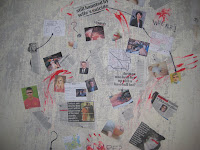
From the thriller; ‘Seven’ i learnt that Iconography is very important in this genre therefore we paid special attention to it. The first shots seen include pictures on a wall, these include violent images of crime scenes and models of dead bodies, we thought this would be a good way to start our thriller as it is instantly noticeable as being a film in this genre.
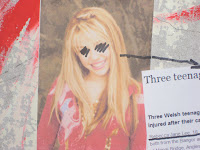
We got the images off of the internet, some were pictures of Celebrities, Maps, Models of dead bodies and Crime Scenes. With any pictures of people that we had, we scribbled out the eyes with black pen, this connotes that the character who did it is psychotic and later on in the film would explain that those with scribbled out eyes were his past victims. We were happy with the result of the images we had on the wall as it does look scary and threatening.
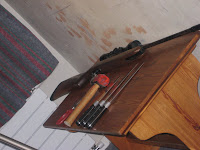
Throughout the rest of the sequence we made sure we regularly included other icons of violence suggesting the genre such as weapons.
Other typical ways of suggesting our genre by using iconography was by filming some shots in dark places and scenes of crime, this comes into lighting and mise en scene also, we found from our research that Mise en scene and Lighting are also very important conventions and are kept similar in all thrillers. There are times when low key lighting is needed in order to create ‘dark places’ and to make the scene and setting look more dangerous. We used lighting in order to represent our characters using more low key lighting on our antagonists, this will be explained more in question 2.
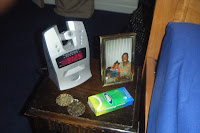
When it came to mise en scene, we found ourselves fortunate as we didn’t need many props due to being mainly set in my house, therefore most of the props seen in the sequence were already there before. The props we did have to find though were very important ranging from guns, pictures of Bea, toothbrush, hair accessories etc to contact lens’.
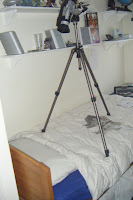
We needed a lot of girl’s accessories and pictures of Bea and Abi in order to make it seem that the setting was really their home, this makes it more realistic for the audience. The room we used for ‘Claire’s’ bedroom was originally a boys bedroom, we used props that belonged to Bea and Abi as well as a pink coloured bed set to make it seem as if it were Claires.
Overall, we didn’t use many props, but those that we did use were ones that would portray a thriller and connote psychotic and chilling things such as the pictures used throughout the sequence and artificial blood made from paint. Usually in thrillers, Urban settings are used, in ours we set it mainly in ‘Claire’s’ home, we did this as it would be unexpected for anything bad to happen, it is also quite creepy as it shows that crimes can take place anywhere at any time. We chose to put Bea in casual clothing and no makeup throughout the whole sequence, this is to make her look more poor in comparison to the house (remembering it is not hers that she lives in). It also connotes that she is having a 'lazy' day at home.
Everything that is seen in the opening 2 minutes of our film is all a dream that Bea (Claire) wakes up from right at the end of our sequence, a dream that includes a lot of flashbacks from Claire’s past where she is kidnapped for the first time. Claire wakes up from this nightmare 3 years later, the film; ‘Behind the Lens’ then continues following the Three-Act Structure;
- Set Up = Claire continues with her life trying to let go of awful past times
- Confrontation = Christian kidnaps Claire and James (Claires Dad) must sort it out.
- Resolution = James saves Claire finally getting rid of Christian whilst he's at it...or so they think.
Another typical convention we have stuck to is structuring our film using oppositional characters, we have the typically found good vs bad, being Claire (The Protagonist) vs Christian (The Antagonist), the narrative then drives towards a resolution of these oppositions. Throughout our opening sequence, we create many enigmas so that many questions are raised by the audience. In order to do this we use restricted narration, questions that may be raised include “why Christian is after Claire”, “Why does he have a red eye?” and “Where is Claire’s family?” These are all questions that aren’t answered until later on in the film.
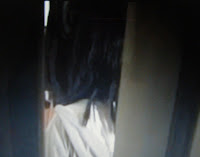
As well as restricting the Narration, we also include unrestricted narration; a time when we do this is close to the end of the opening sequence, the POV shot looking at Claire as she switches the light switch on and off is an example of unrestricted narration, it is an example of Omniscience. As the audience can tell there is someone behind the protagonist. This means the audience know more than the character does. In order to help create enigmas, unrestricted and restricted narration, we needed to pay attention to the conventions of camera work and editing that are usually seen in thrillers today. Due to only having 2 minutes for our sequence, we wanted to fit in as many techniques as possible, but still keep it looking realistic and not over the top. We used many techniques such as POV shots and reaction shots. We included many in which, something sudden occurs, for example, the POV shot of Claire through the window is subjective and quiet, then all of a sudden, a hand hits violently against the window, this is a favourite shot and along with the non-diegetic sound used, creates a very edgy and jumpy atmosphere.
Throughout the 2 minutes, we used quick cuts, this is to build pace and tension but to also not interrupt the audience from what’s going on so that they are able to focus on mise en scene etc easily. There aren’t many long lasting shots therefore along with the cuts, it all happens quickly building suspension. We used many Mid shots and Close Ups throughout our piece, the close ups all occur when filming the photos on the wall, we knew close ups would be best to use for these shots as the photo then takes up the whole frame allowing the audience to analyse it. In most of our shots including the characters, we used Mid Shots and Long shots, mid shots worked well as the facial expressions of the characters are significant as well as the mise en scene and surroundings being able to be appreciated also. One of the rare long shots we used was taken outside looking at Claire on the phone, it is not noticeable to start off with but it is soon clear that there is an actor to the right of the frame, when Jack Storer's character: Christian Greeko suddenly moves out of the shot, this could create suspension as the audience then know the antagonist is near.
Along with the camera work must come good editing in order to provide a successful thriller. When making the titles to our film, we made the font style seem quite ghostly, we did this by making the colour of it white and putting an effect to it making it slowly drift either left or right. Other effects that we put to the titles would make them jilt suddenly, this was liked by everyone in the group as we felt it made a very creepy impression and could be seen as a typical title for a thriller.
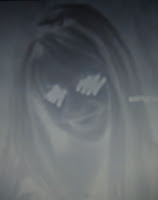
With few of the horrific images on the wall at the beginning, we also put an effect to these, we would make sure we had an extreme close up on them and then put an effect called X-ray on it, this would invert the colours making it go very bright, we liked the effect this had on some of the images making them look very ghastly and horrifying.
When our sequence first starts, the title ‘Moonface Productions’ comes up, along with this we have non-diegetic music to it, when doing the music and sound, i made sure i picked the right tracks from Garage Band so that it was parallel with the genre and fits with what’s seen on screen. We use many stringed instruments for tense moments as well as percussion including drums, these all build suspension. In some shots, you will notice that the sound is quite dodgy including the first shot you see of the psychotic pictures on the wall. This is the natural sound that was in the room at the time of recording, the wind was strong outside that evening and we felt along with it sounding crackly, as if there was a bad signal, it made a good effect. We used this natural sound for a few shots, all including the psychotic pictures. In some shots, we used many sound effects including sudden drums making a ‘bang’ sound for jumpy moments, such as being used for the mirror shot. I was very pleased with the sound effects making sure they were perfectly in time with what was seen on the screen including the hand being smashed against the window. The music keeps building up until Claire hears Christians voice over the phone, we then use the diegetic sound effect of a ‘cut call’ as if Christian hung up. The music then gradually builds up again, still non diegetic to when she is switching on the light switch. Strings are introduced in a loud tempo to really build suspension and create a tense atmosphere within the audience, as they know something is going to come out of the room behind her, but don’t know when or who. The music then cuts quickly as the attacker comes in from behind her, we then used a ‘Scream’ showing the audience her fear and pain. This scream was a voice over rather than a sound effect on garage band so that we could really use Bea’s voice making it more realistic. After the part where Claire is bagged from behind, the title “Behind the lens” cuts to the next shot with a thunder sound effect, we used this as we felt it connotes danger and violence but also that it was quite shocking. This then slowly fades out whilst the camera gradually tilts up showing more and more of the antagonist, the shots of both antagonists cut from one another showing more and more of them, one being Christian and the other being Christians hit man.
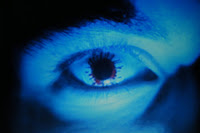
A last sound effect is used when we see an ECU of Christian’s eye, due to it having much significance in our film, we wanted the sound effect to be loud and sudden, we felt we chose well.
On the whole, I found our project went really well, we managed to overcome our obstacles and produce a good opening sequence for our thriller. We managed to get feedback on our sequence from others in our class, we found from these that our main strength on average was our special effects and Foleys. Comments we received explained how that our Foleys were very well done in time with our filming. The special effects were easily seen as being used for a thriller also and so therefore did what they were supposed to do. The graphic match that we had at the end of our opening sequence was the part that received the most positive feedback, fading and joining the two eyes together worked well and showed the audience that it was a dream she woke up from. It was an exciting way to show the audience that time has passed but to also provide continuity between shots.
2. How does your media product represent particular social groups?
In our opening sequence, the main group that is represented in our product is gender, we use the stereotypical characters for a thriller including the damsel in distress, being a female, and the murderer/psychopath, being male. You can learn a lot about the characters and the way they are feeling due to the camerawork, mise en scene, sound and editing throughout our sequence. The first shot comes on with the first title, ‘Moonface productions’, this has already been analysed in question 1, what wasn’t said is that it represents something about the antagonist, we have used the same effects with most of our titles making them stutter from side to side rapidly, this can connote that the antagonist is psychopathic and that he may also be very aggressive, in my opinion these effects show a sign of rage. The opening shot includes many pictures set out on a wall along with cut out newspaper articles, maps etc. This all helps to give the audience an idea of how psychotic the antagonist is, there are pictures including people of both sex, this tells us he kills all kinds of people.
The first shot we come across including a character is of Claire getting out of bed, in this you do not see her face, this is restricted narration and can cause enigma, you do not see the protagonists face for a number of shots more. The audience can tell she must be the protagonist due to the colours in her room and on her bed, these are light and bright connoting harmlessness.
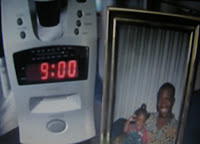
The next shot is a high angle shot of a picture and a clock, the picture is of her and her Dad when they were both younger, this shows the relationship must be good between them due to them smiling and sitting close together. The fact that she has a picture of her Dad beside her bed could make the audience wonder if he is not around, the fact it is beside her when she sleeps may show that he must be special to her and missed. The real reason for this is that he is special and rarely gets to see her due to always working, you can read about this in the synopsis.
The mirror scene creates an enigma when the second character is seen, she pops up behind Claire in the mirror, along with the music this is seen as shocking and jumpy, the question the audience will be asking is “who is she?”, a voice over then comes on with the dialogue; “Are you ok?”, this calms the audience down telling them she is harmless and must be known by the protagonist. The mise en scene and decor of the room shows that where they are is of reasonable wealth, it is not till later on that you find out Claire lives with her Uncle, Aunty and Cousin, you can find this out in the synopsis.
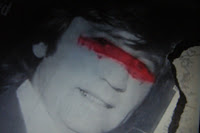
The next oncoming shots are ones that tell us a bit more about the antagonist of the story, another picture, this time of a middle aged male with his eyes painted over with what’s supposed to be blood, we did this by using red paint. This shot helps give off the impression that the murderer is extremely violent and psychopathic and along with the effects, it can be frightening.
The weapons on the table are neatly placed in order of size also, this shows how organised Christian must be. The cut out newspaper articles include titles for stories explaining the murders that Christian has done, these are on the wall also explaining that Christian must be proud of what he has done building a sick, abnormal image. The clothing throughout on Claire is quite casual and cheap whereas the clothing of both antagonists is formal including shirts, trousers and a long black coat. This reminds us of their parts in the film, Claire being the damsel in distress who doesn’t expect any of it, whereas Christian and his hit man are experienced kidnappers and killers. From this point on, many of the shots of Claire are taken from a high angle, this is in order to show how low she is feeling, the audience want to empathise for her and feel what she is going through, which by this point is pain and fear.

The extreme long shot taken from outside looking at Claire on the phone makes her look lonely and along with body movement and facial expressions, gives us an idea what she is going through.
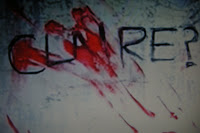
‘Claire’ is written on the antagonist’s wall in one shot, this proves that Christian has planned on kidnapping her for a while and builds on the image of him being an obsessed serial killer.

Once the POV shot has been shown, being unrestricted narration, the audience know there is someone behind her, “but whom?” Bea (Claire) slowly moves across to look upstairs, the camera is still so that Claire’s face is then in the corner of the screen, the audience expect that the antagonist will jump out in the same shot due to the spacing, we then cut to our next shot for him to jump out on her to add more unexpected shock. The scream that is then heard was done by a voice over, this tells the audience that Claire is going through pain. The slow tilt that is used shortly afterwards builds suspension, this then cuts between shots of Christian making it tense and creating enigmas “Are they both together?”
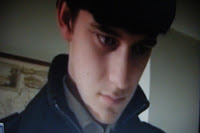
The final low angle of our hit man (Jack Sadler) shows he is a dominant, aggressive man and how dangerous he is. The red eye is then noticed on both of them, it is then finally realised that they must be working together. In our last shots we used low key lighting on Christian in order to portray he was an antagonist, the lighting made him seem threatening and cautious.
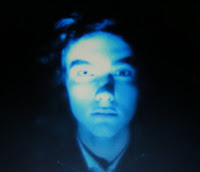
We used a blue screen to cover the light in order to make the lighting darker, we also preferred it creating a blue shadow on his face as we felt it made him look more scary. We were pleased with the way the contact lens stood out, it wasn't easily noticeable as being a contact lens but the eye still stood out as being weird and having something wrong with it.
3. What kind of media institution might distribute your media product and why?
There are 3 stages that a film must go through, these consist of Production, Distribution and Exhibition. As Director of ‘Behind The Lens’ all my group and i have to worry about is making the film and finding a Distributor who is able enough to release our film to its audience and distribute it well. If we were to finish producing our film, it would be our jobs to find a Distributor who is right for the job in releasing it, getting it to our specific audience and increasing the popularity of our film.
Film Distribution is known as the “Invisible Art”, this is because many people never think about it and that their work is never seen or known by any audience. What you don’t see is that those who distribute have a lot to do, their first job is in Licensing, this is where distributors must acquire legal rights to exploit a film and they can do this by paying the producer either before it is released or after. What they get back is a share of cinema profits for example. Now if we could choose from any distribution company, we would choose a most popular one such as 20th Century Fox, Universal, or Paramount Pictures for example. This is because any audience that may see it is distributed by these companies might instantly expect the film to be good and therefore go and watch it. These distributors only release mainly family films and blockbusters, they have bigger competition and therefore it would be very doubtful for them to come and pay us for our thriller film. I thought about this and so researched smaller distributors that focus on thrillers just as much as any other genre. I came across Icon Film Distributors, helping to release films such as 30 Days of Night, Black Sheep, Awake and The Butterfly Effect, they are more experienced with thrillers and therefore would be more necessary than 20th Century Fox etc.
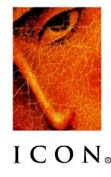
Their logo is also quite popular being shown at the beginning of all the thriller films they have worked with, it denotes half a face that has been painted, this image is well known and when seen, gives the audience an idea that the film must be within the thriller genre.
Pathe is another popular distributor known for films such as Chicken Run and Michael Clayton, they have had distribution rights for approximately 300 films. This is a distributor that would be doubtful to come to us due to its size, competition and popularity also. The only other disadvantage is that they have only distributed 5 thrillers including Adrift. The link to their site is http://www.pathe.co.uk/ showing some of its new releases.

One that caught my eye was a distributor called Optimum Releasing, reasonably young in the market, its inception was in 1999, and this could mean if we were to produce a full length film, they could be more interested than the others I have pointed out due to not having as much experience. They have worked with many thriller films releasing many popular ones such as The Zodiac and Wolf Creek. Being a UK-based, all rights company servicing the release of feature films across Theatrical, Video, Television and Online media, it has therefore acquired a reputation for a dynamic, marketing-orientated approach to distribution. Optimum releasing distributors were definitely one of the best i found. http://www.youtube.com/watch?v=YYINaGsnmpw
The main jobs for a distributor to do are marketing and advertising your product. If i could choose a time to release the film, i would release it in a school holiday in order to get college students etc to have the time in going to the cinema, the time of the year would be winter or spring, this is because it is the rainiest, dull time of the year and therefore many people won’t be outside as much. I would make sure the film is released in a week where there are no other thrillers being released, otherwise there would be a lot of competition. If there were to be a lot of thrillers being released near the same date, distributors may not even pay to license your product. When advertising, i would use as many ways as possible to show off ‘Behind The Lens’, of course there would be problems with costs therefore the best ones to use would be TV adverts, Internet, Bill Boards shown on bus stops for example and magazines.
4. Who would be the audience for your media product?
Overall, thrillers can target a wide audience ranging from teenage males to middle aged women, it really depends on the type of thriller and sub genre. Like all thrillers, there are many sub genres and to really give an accurate answer to who our target audience would be, i have to specify what kind of thriller film ours fits in to. Silence of the Lambs and No Country for Old Men are considered the two best thrillers in recent memory and they're rated R. Their target audience was mainly young male adults ranging from 18-30 years old. Meanwhile, there are those thrillers that are borderline horror films, such as The Sixth Sense, Signs and The Village. Since they are border lining horror, the demographic would be slightly different targeting more females. Recently, many horror films have been targeted towards a younger age range from 15 years, films including The Strangers, The Haunting in Connecticut and The Unborn.

Some of these could be found very surprising being only rated at 15, this is because they can be seen as very scary with many jumpy moments, but then, ratings have certainly lowered in recent years allowing teens to have the opportunity in watching a wide range of thrillers and horrors. The trailer for The Haunting in Connecticut really shows how scary it is: http://www.youtube.com/watch?v=pP_gucF7y0E. Then there are legal thrillers such as Fracture and Runaway Jury and crime thrillers including Memento and Se7en that target a more mature audience. Classic thrillers with those made from Alfred Hitchcock are rated PG but are intended for adults.
The audience for our film will be viewers who are interested in films which are scary and are enticing to watch. However there is an age restriction on our film. The target audience is for 15 years and above. The reason for this is because we believe the minimum age of 15 can understand clearly the context of the film. We believe that the reason why it’s a 15 and above is because the mind of someone under the age of 15 and may not be able to understand it fully. With the age restriction we can safely be assured that there will be no complaints at what age our film is aimed at. Overall i feel the best age range for us would be 15-25, anyone over this may not find it as exciting and enjoyable as the younger generations. I feel with the way that thrillers have been targeting more females in recent years, ‘Behind the Lens’ would also suit this gender as well as males. Females have been found to the thrills as much as males, our film would be able to shock the audience as well as give them enigmas to try and figure out and a good storyline. With our main character being male (Claire’s Dad), this may mean more males would come and watch it, if the actor playing the part was popular and good looking, i feel more females would watch it. Therefore in my opinion, ‘Behind the Lens’ would target mainly teens, the overall age range would be from 15-25.
5. How did you attract/address your audience?
Looking at our opening sequence, I feel we could make a film that would attract our audience well including a good story told through the narrative, good camerawork, mise en scene, use of character and parallel sound. Our characters were the stereotypical characters that are commonly found in thrillers today, for example we made sure we had a female actress playing the part of Claire, she is then seen as the damsel in distress which is often found and used in this genre. When we were thinking about who to use for our antagonist; the Psychopath, we found that all our ideas were male actors, this is because the typical stereotype for a psycho, serial killer is seen as a cunning, poor, trampy looking male who was badly brought up. A film that hasn’t used this stereotype for their crazy antagonist was Fatal Attraction directed by Adrian Lyne.See the trailer on this link: http://www.youtube.com/watch?v=IYpeKbHKVbU
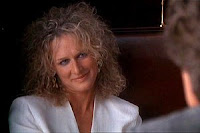
In this film the antagonist is a middle aged, wealthy woman who is then later seen as a crazy, obsessive character. Our main protagonist of the story is Claire’s Dad, being a bodyguard for a local MP of high importance, this may be seen as a taboo due to his race, but seeing him with this authority in his job links with current themes and issues such as Obama in the US. I feel we have attracted the audience well in use of characters, the main protagonist being male could attract males due to them being able to put themselves in his position with his lifestyle for example.
I feel the story for our thriller would be successful in receiving a wide audience, it includes a story packed full of attention and empathy, you follow James Adams (Claire’s Dad) through his life for a week once Claire has been kidnapped, this story includes upsetting times full of suspension.
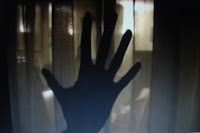
Our opening sequence includes many edgy scenes and shots that should make the audience jump including the shot of the window when suddenly a hand smashes against it. I feel our story Is perfect for the age rating I recommended our thriller in question 4, this is because it can be understood by people of 15 years and yet, be exciting enough for those in older generations.

One problem I feel our film would come across is that in some ways it is similar to the film: Taken, released in 2008 and directed by Pierre Morel, it includes a similar storyline with a former spy relying on his old skills to save his estranged daughter who has been kidnapped and put into the slave trade. Due to this film doing well in cinemas, it would be difficult to release our film close to the time, therefore we would release ‘Behind the Lens’ at a later date. ‘Behind The Lens’ includes a lot more restricted narration and therefore increases enigmas.
The use of camera helps this in creating the restricted narration and omniscience, with editing it causes suspension the whole way through, we use a variety of very short lengths in shots as well as some long lasting shots including the mirror scene, both build suspense and create tension. Our sound also helps create a thrilling atmosphere, with it being parallel, this makes it intense and exciting the whole way through. If it were contrapuntal, it would bore the audience. In many films, something as little as clothing in a film could attract the audience, mise en scene is also important for this. A good example is the series ‘Skins’, when advertising, you could tell what was going to be included throughout the series, they addressed the audience through clothing and props, anyone who wears the same clothes in normality to those used in a film will feel it may relate to them and therefore go and see it. I feel throughout our opening sequence we didn’t do this much, but if we were to make a whole film we would include more props etc that could relate to more people.
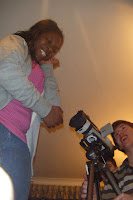
I feel overall, we did well in addressing our audience through story, narrative, camera work and sound, if we were to do it again, we would add more to clothing and props, but I feel the clothing used throughout our sequence had to be like it is as we wanted a casual look on Claire and a smarter, cunning look on the antagonists’.
6. What have you learnt about technologies from the process of constructing this product?
The equipment we used and were able to book out from our college includes:
• Digital Cameras
• Digital Cameras
• XM2
• Tripod
• Dictaphone
• Lighting and Lighting Equipment
• Dolly
Throughout our project, we made sure we booked out the XM2 Digital Camera each time, this is because we used it in our first rushes, and therefore we needed to keep the same picture quality throughout. As head of Directing I found that it is very important to make sure white balance has been used before any filming has been done every time you change setting. It is also very important to make sure there are no finger prints on the screen of the XM2 as this is easily noticeable when put on screen. Once we had finished our rushes, we had to upload them onto the college Macs and start our editing, we used the programme IMovie in which we used transitions and effects to edit our sequence. We used GarageBand to put music and sound to it including voiceovers and Foleys. To create our final piece, I learnt a lot about the editing programmes and how to use them well. I learnt how to add many different effects such as X-Ray as well as how to put on titles. It has also helped as I now know what can be found on these programmes. I feel I am now fully educated and would be able to create a good piece of coursework for our second task in A2.
I feel throughout the project, i learnt a lot about thrillers and the conventions commonly found, i put the training i received at the beginning of the term into my filming, editing, music and sound and with the rest of the group doing the same thing, i reckon we produced a decent thriller. Once everyone in our class had completed their final product, we all received peer evaluations from every individual. We found our results were mainly very good, the best part of it in other peoples opinion was the camera framing and the part that needed improving on was the editing. I agree with the peer evaluations, i put a lot of effort into the framing making sure that everything that was seen in the frame was meant to be there including props, clothing, make up etc.
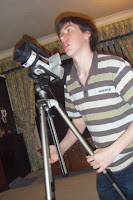
The actors found me to nag quite a bit about where they stood in the frame, it was good to see that it was put to good use in the eyes of the audience with no mistakes. I feel the editing was our let down, we did not include many shots that we could provide continuity with, most of our sequence were shots from one setting, quickly cutting to those of another. I feel in order to improve our opening sequence, if we had another chance would be to include more match on actions, shot/reverse shots and more occasions using the 180 degree rule. Because we never had a scene including on-screen dialogue this was difficult to do, we only included voice over’s and therefore we had no time to use the 180 degree rule or shot/reverse shots. One match on action we used was the shots of her getting out of bed and going to the bathroom at the beginning of the opening. I feel I did a good job with filming and editing in making it flow well providing good continuity. Apart from being head of directing, i had a big part in editing, i would make sure i had plenty of time so that i could be in the editing suite in order to finish our product before the deadline. Other jobs i did was making the music/sound. The non- diegetic track and sudden sound effects, along with the diegetic sound effects were in time with what was seen on screen and helped creating realism. Another main weakness to our thriller was the voice over’s that were used over the titles, these sounded different to the dialogue used from the source.
7. Looking back at your preliminary task, what do you feel you have learnt in the progression from it to the full product?
Since our preliminary task, i feel I have progressed in technical skills, use of editing, construction of characters, construction of story and construction of typical conventions used. Looking back at my preliminary exercise evaluation i can tell just how little work we had done in comparison with our thriller. We used the same programs on the college Macs including IMovie and GarageBand, since our preliminary, we have improved a considerable amount by adding more effects, better titles and use of transitions.
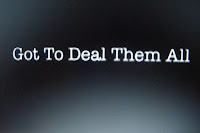
One point we haven’t improved on since our practise exercise with ‘Gotta Catch Them All’ was our use of continuity, within our preliminary exercise, we made sure we used a match on action, shot/reverse shot and kept the 180 degree rule. This is due to the instructions telling us we had to include it all, without the pressure of having to include them in our thriller, it is found that we could only include one match on action and nothing else with all the shots we had.
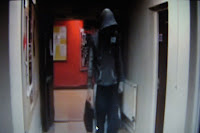
With the construction of characters i feel we made a big improvement with our imaginations on who our antagonist could be in our thriller, we used an original, hooded character as our main character for our preliminary, this would be seen too many times from any audience and isn’t seen as scary anymore, therefore we had to think of something different. The eye lens came to thought and we liked the idea instantly knowing it would be more exciting than using a hooded antagonist.
Looking back, i see we used no Foleys or sound effects throughout our preliminary, only a track that we kept throughout the length of time it was playing. If it had been our thriller, the music used would have been contrapuntal, but due to us trying to achieve the ‘chav’ look in our preliminary, the music in that was also quite parallel. We may have improved a lot since our practice preliminary sequence, but it took a lot of hard work from each person in our group and a lot of props etc. We found ourselves doing a lot to get the time in which we could spend on rushes and editing and have therefore improved in commitment, even though we had many problems with all getting together at the same time. This is mentioned in our blog post: “The Problems We Had Throughout The Whole Project”.
We also received peer evaluations for our preliminary, i can see from these that our main strength was our editing used, this is very different to those received from our thriller as editing came up as our main weakness for our thriller.
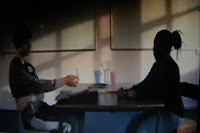
I know for next time to make sure we pay specific attention to editing just as much as everything else and include many ways to provide good continuity. Our weakness’ in the preliminary included bad lighting and boring location/setting, therefore it is obvious that we have made clear improvements on this with more imagination and better control over lighting. We used the lights in every shot for our thriller whereas throughout the preliminary, due to it being all in daylight, we used natural lighting for most of it.
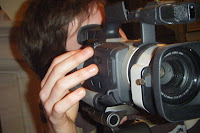
Overall i am thrilled with the improvement my group and i have made and the skills i have acquired along the way. It has been a great project and i am thoroughly looking forward to the next one.









































